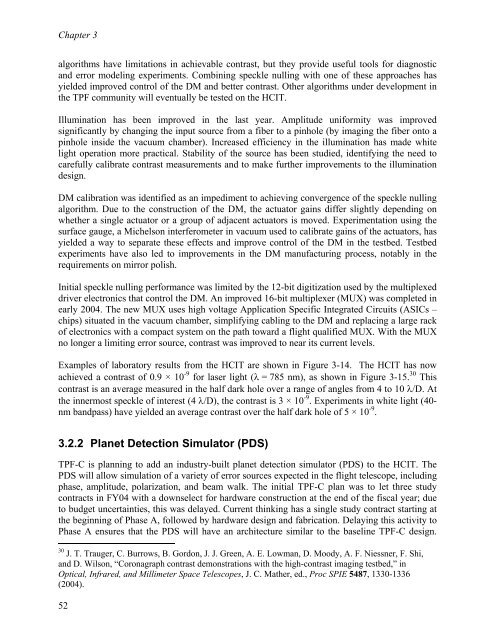TPF-C Technology Plan - Exoplanet Exploration Program - NASA
TPF-C Technology Plan - Exoplanet Exploration Program - NASA
TPF-C Technology Plan - Exoplanet Exploration Program - NASA
You also want an ePaper? Increase the reach of your titles
YUMPU automatically turns print PDFs into web optimized ePapers that Google loves.
Chapter 3<br />
algorithms have limitations in achievable contrast, but they provide useful tools for diagnostic<br />
and error modeling experiments. Combining speckle nulling with one of these approaches has<br />
yielded improved control of the DM and better contrast. Other algorithms under development in<br />
the <strong>TPF</strong> community will eventually be tested on the HCIT.<br />
Illumination has been improved in the last year. Amplitude uniformity was improved<br />
significantly by changing the input source from a fiber to a pinhole (by imaging the fiber onto a<br />
pinhole inside the vacuum chamber). Increased efficiency in the illumination has made white<br />
light operation more practical. Stability of the source has been studied, identifying the need to<br />
carefully calibrate contrast measurements and to make further improvements to the illumination<br />
design.<br />
DM calibration was identified as an impediment to achieving convergence of the speckle nulling<br />
algorithm. Due to the construction of the DM, the actuator gains differ slightly depending on<br />
whether a single actuator or a group of adjacent actuators is moved. Experimentation using the<br />
surface gauge, a Michelson interferometer in vacuum used to calibrate gains of the actuators, has<br />
yielded a way to separate these effects and improve control of the DM in the testbed. Testbed<br />
experiments have also led to improvements in the DM manufacturing process, notably in the<br />
requirements on mirror polish.<br />
Initial speckle nulling performance was limited by the 12-bit digitization used by the multiplexed<br />
driver electronics that control the DM. An improved 16-bit multiplexer (MUX) was completed in<br />
early 2004. The new MUX uses high voltage Application Specific Integrated Circuits (ASICs –<br />
chips) situated in the vacuum chamber, simplifying cabling to the DM and replacing a large rack<br />
of electronics with a compact system on the path toward a flight qualified MUX. With the MUX<br />
no longer a limiting error source, contrast was improved to near its current levels.<br />
Examples of laboratory results from the HCIT are shown in Figure 3-14. The HCIT has now<br />
achieved a contrast of 0.9 × 10 -9 for laser light (λ = 785 nm), as shown in Figure 3-15. 30 This<br />
contrast is an average measured in the half dark hole over a range of angles from 4 to 10 λ/D. At<br />
the innermost speckle of interest (4 λ/D), the contrast is 3 × 10 -9 . Experiments in white light (40-<br />
nm bandpass) have yielded an average contrast over the half dark hole of 5 × 10 -9 .<br />
3.2.2 <strong>Plan</strong>et Detection Simulator (PDS)<br />
<strong>TPF</strong>-C is planning to add an industry-built planet detection simulator (PDS) to the HCIT. The<br />
PDS will allow simulation of a variety of error sources expected in the flight telescope, including<br />
phase, amplitude, polarization, and beam walk. The initial <strong>TPF</strong>-C plan was to let three study<br />
contracts in FY04 with a downselect for hardware construction at the end of the fiscal year; due<br />
to budget uncertainties, this was delayed. Current thinking has a single study contract starting at<br />
the beginning of Phase A, followed by hardware design and fabrication. Delaying this activity to<br />
Phase A ensures that the PDS will have an architecture similar to the baseline <strong>TPF</strong>-C design.<br />
30 J. T. Trauger, C. Burrows, B. Gordon, J. J. Green, A. E. Lowman, D. Moody, A. F. Niessner, F. Shi,<br />
and D. Wilson, “Coronagraph contrast demonstrations with the high-contrast imaging testbed,” in<br />
Optical, Infrared, and Millimeter Space Telescopes, J. C. Mather, ed., Proc SPIE 5487, 1330-1336<br />
(2004).<br />
52
















